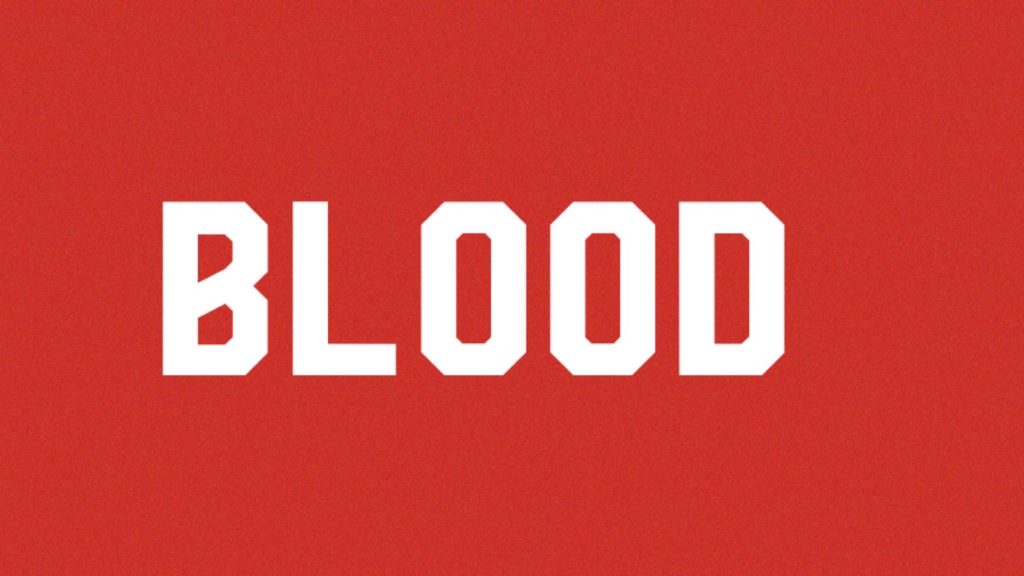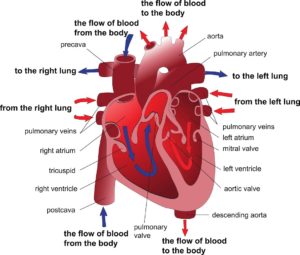
WHAT IS BLOOD?
Blood is a red body fluid in human and vertebrate that is pumped through the body by the heart . It performs many important functions within the body that includes transporting of essential elements such as nutrients and oxygen to tissues and carries harmful metabolic waste products away from the body. The average adult has about 5- 7 liters( 9-12 pints) of blood in a human body. Blood accounts for 7% – 8% of the human body weight. By volume, the red blood cells constitute about 45% of whole blood, the plasma about 54.3%, and white cells about 0.7%. Usually, females are found to have slightly lesser amount of blood, as compared to males. Adults have more blood in their body, than in kids.
3 MAJOR BLOOD VESSELS:
- Arteries – are blood vessels that carry blood away from the heart.
- Veins – blood vessels that carry blood toward the heart.
- Capillaries – a very thin and fragile blood vessels where exchange of oxygen and carbon dioxide takes place.
**Materials exchanged in capillary walls…..Oxygen,Nutrients,Carbon dioxide, wastes.
**Arterial blood is the means in supplying the tissues with oxygen and nutrients, as it is rich with those constituents.
**Venous blood is the means by which carbon dioxide and metabolic waste are transported to the lungs and kidneys, respectively, for transporting away from the body.
BLOOD CELL FORMATION:
- Hemopoiesis,Hematopoiesis –is the process to produce new blood cells that includes formation, development and differentiation of blood cells in the bone marrow
- Erythropoiesis –is the process by which red blood cells (erythrocytes) are formed from stem cells in the bone marrow.
- Leukopoiesis –is the process by which white blood cells (WBC, or leukocytes) are formed from stem cells in the bone marrow.
- Thrombopoiesis – is the process by which platelets are formed in bone marrow.
- Bone Marrow- is the spongy fatty tissue found inside some of your bones, such as your hip, sternum and long bones. The bone marrow contains cells that are responsible for the production of red blood cells that carry oxygen through your body, the white blood cells that fight infections, and the platelets that help with blood clotting
3 CORPUSCLES / 3 ELEMENTS FORMED IN THE BLOOD:
1) Red Blood Cells (RBC) or erythrocytes – are the most common type of blood cells. Red Blood Cells primary duty is to transport oxygen from the lungs to the cells of the body. RBCs is color red because it contain a protein called Hemoglobin. Hemoglobin which is bright red in color, and contains the element Iron, actually carries the oxygen. Red Blood Cells have a life cycle of about 120days.
2) White Blood Cells (WBC) or leukocytes – are cells of the immune system that helps in defending the body against infections. Mature WBCs have a life span ranging from about a few hours to several days. WBCs are characterized as granulocytes and agranulocytes.
Granulocytes– leukocytes chracterized by the presence of granules in their cytoplasm..
- Neurophils-are the one of the body’s main defenses against bacteria and most abundant type of white blood cells. They are one of the first responders to the infection site to attack the bacteria. They kill bacteria by ingesting them, called phagocytosis.
- Eosinophils – kills parasite, and have a role associated with allergy, asthma and in fighting viral infections
- Basophils -are very rare , are the least common and are not well understood, but they function in allergic reactions. Basophils contain heparin, which prevents blood from clotting fast. They also contain histamine, which promotes blood flow to tissues. When stimulated they can release histamine and heparin to respond to a suspected infection.
Agranulocytes -leukocytes characterized by the absence of granules in their cytoplasm
- Monocytes -from the bloodstream, they enter the tissue, where they become larger and mature into macrophages, the main scavenger cell of the immune system. There they can phagocytize bacteria (up to 100 in their lifetime) throughout the body.
- Lymphocytes- after neutrophils, lymphocytes are the most common type of white blood cell. They attack foreign bodies by forming antibodies or phagocytes them.
3) Platelets or thrombocytes- are smaller than RBCs or WBCs. They circulate in the blood and are involved in hemostasis. The main function of platelets is to prevent excessive internal or external bleeding after an injury. They help the blood clot. Platelets have a life cycle of about 7 days.
BLOOD FLOW INSIDE THE HEART

Right side of the heart: ( deoxygenated blood)
BODY — deoxygenated blood enters —>> inferior and superior vena cava —>> empties dexygenated blood to right atrium –>> enters right ventricle via tricuspid valve –>> deoxygenated blood leaves the heart via pulmonic valve –>> pulmonary artery –>> LUNGS (oxygenation takes place) ——->>
Left side of the heart: (oxygenated blood)
oxygenated blood returns to the heart—via pulmonic veins –>>left atrium—-via mitral valve –>> left ventricle –>> blood leaves the heart via aortic valve –>>aorta —>> BODY
Blood Disorders:
Anemia: is a condition wherein the bone marrow does not produce enough red blood cells that contain hemoglobin and Iron. Persons with anemia have symptoms such as: fatigue, shortness of breath, palpitations, and feel tired. A Blood Test that can diagnose anemia is called CBC (complete blood count).
Iron-deficiency anemia: is a common anemia due to low dietary iron intake or blood loss, can be caused by abnormal heavy menstruation or intestinal bleeding. Several types of treatment are available, including iron supplements, or sometimes blood transfusion depending on the Hgb and Hct levels.
Pernicious anemia (B12 deficiency): is a blood disorder caused by the inability of the body to absorb Vitamin B12 due to insufficient gastric protein called intrinsic factor. Intrinsic factor plays an important role in absorption of vitamin B12. Symptoms may include weakness, fatigue, and fast heartbeat.
Thalassemia: is a genetic form of anemia that usually has no symptoms. This kind of disorder is caused by either an abnormal form of hemoglobin or the production of low amounts of this hemoglobin that leads to anemia. In case of a severe form of thalassemia, blood transfusions may be needed. Symptoms are weakness and fatigue. Eating a healthy diet, which includes bright colored fruits and vegetables, and exercising regularly may ease the symptoms.
Polycythemia vera: is a blood disorder caused by excessive red blood cell production by the bone marrow. These extra red blood cells can result in thickening of the blood and may increase the risk of a blood clot.
Leukemia: is a cancer of the blood caused by the abnormal increase in production of white blood cells (leukocytes) by the bone marrow.
Treatments include:
- Chemotherapy
- Radiation Therapy
- Bone Marrow Transplant
Signs and Symptoms:
- Bleeding
- Anemia
- Easily bruised and bruises heal slowly
- Infection
- Weight loss
- Fatigue
- Fevers
Folate-deficiency anemia (also known as megaloblastic anemia, Folic Deficiency Anemia, and Vitamin B12 Deficiency Anemia): is a blood condition that develops when the body has an insufficient amount of folate or folic acid which is a type of B vitamin. Folate is essential for red blood cell production. Hence low levels of folic acid in the body decrease production of red blood cells. In Folate-deficiency anemia, the red blood cells are abnormally large and that’s the reason why it is also called megaloblastic anemia. Green leafy vegetables and liver are rich in folic acid.
Some of the symptoms are:
- Fatigue
- Pallor
- Weakness
Causes:
- Inadequate amount of folic acid in your diet
- Alcoholism
- Pregnancy – Folic acid is important during pregnancy for the healthy and normal growth of the fetus. Insufficient or too little folic acid may lead to birth defects of the brain and spinal cord called neural tube defects.
Prevention/ Treatment:
- Beans and legumes
- Dark green leafy vegetables such as Broccoli, spinach, kale and others
- Liver
- Poultry, pork, and shellfish
- Folic Acid vitamin supplement – over the counter or as prescribed by an MD
Sickle Cell Anemia: is a genetic disorder of the blood, characterized by a stiff and sickle shape (crescent shape) of the red blood cells, instead of the normal round shape RBCs. A person with one defective gene display both normal and abnormal hemoglobin.
Sickle cells consist of abnormal hemoglobin called hemoglobin S or sickle hemoglobin which gives the RBCs a sickle (crescent) shape.
Due to the abnormal shape, the red blood cells cannot move easily through the blood vessels, causing them to block the vessels, hence leading to severe pain, rigidity, and tissue and organ damage.
The life span of sickle RBCs is only 10-20 days compared to the normal 120 days. They are fragile and break apart easily. RBCs number decreases due to early rupture, thus leading to anemia.
For sickle cell anemia to occur, both parents have the sickle cell gene, so that the child has two copies of the sickle cell gene. A child with just one copy of the sickle cell gene is termed as having sickle cell trait or as a sickle cell carrier. These persons do not have anemia and do not have many symptoms of the disease. When a father and a mother are both carriers of the sickle cell trait, their children have a 1 in 4 chance of having sickle cell anemia.